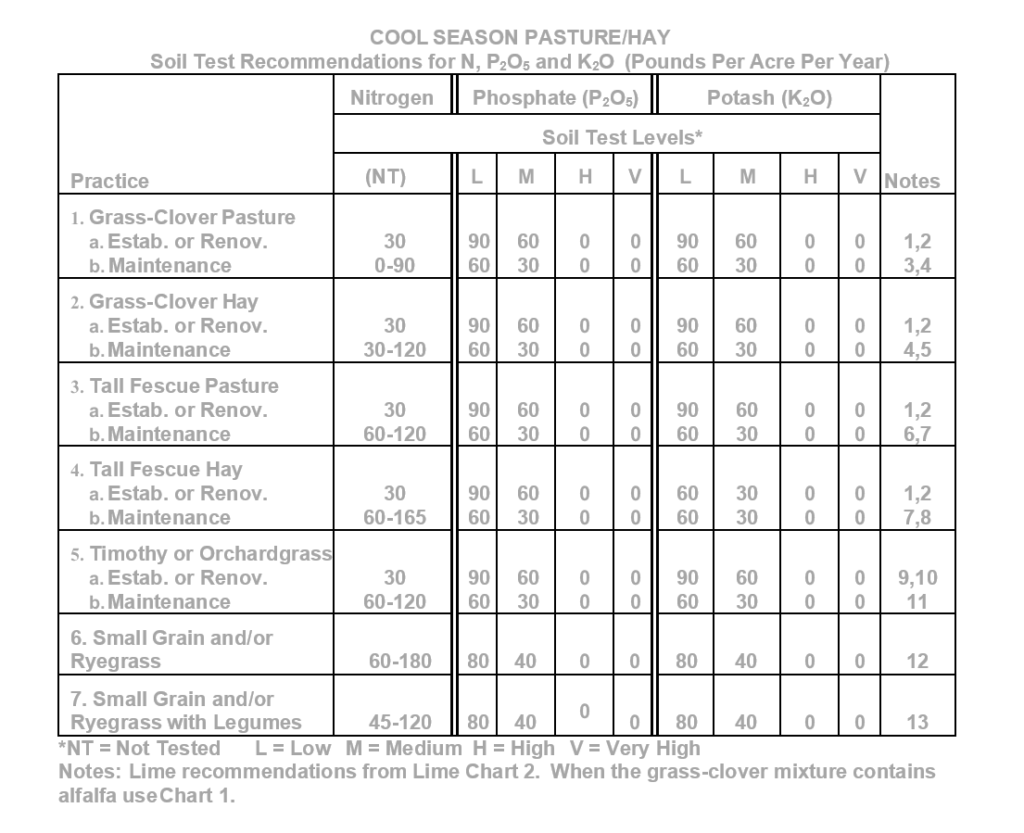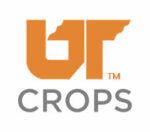Cool Season Pasture / Hay

- Each pasture/hay sample has two recommendations. The first should be used for new crops or to renovate an existing crop. The second should be used for maintenance of an existing crop. For future maintenance of the new or renovated crop, use the second recommendation and omit the lime recommendation until the field is re-tested. Soil test every two years.
- If renovation involves the addition of legumes to grass pastures/hay the nitrogen should be omitted.
- The nitrogen should be omitted on pastures containing more than 30 percent clover in the spring, otherwise if clover is less than 30 percent of the pasture apply 30 pounds of nitrogen per acre between March 1-30. For fall stockpiling of fescue apply 60 pounds of N per acre August 15 to September 15 to all fescue-clover mixtures. A urease inhibitor is suggested for use with non- incorporated urea-containing nitrogen sources.
- Apply recommended amounts of phosphate and potash in one application anytime during the year. If more than 4 tons of lime per acre are required, apply only 4 tons of lime per acre and re-test after two years.
- Apply 30 pounds of N per acre March 1-30 and again after first cutting if an additional cutting is For fall stockpiling of fescue apply 60 pounds of N per acre August 15 to September 15 to all fescue clover mixtures. A urease inhibitor is suggested for use with non-incorporated urea- containing nitrogen sources.
- Apply recommended amounts of phosphate and potash in one application anytime during the year. Apply 60 pounds of nitrogen per acre August 15 to September 15 and from March 1 to March 30. If additional growth is only needed during one season, apply nitrogen for that season only. A urease inhibitor is suggested for use with non-incorporated urea-containing nitrogen sources.
- If more than 4 tons of lime per acre are required, apply only 4 tons of lime per acre and re-test after two years.
- Apply recommended amounts of phosphate and potash in one application anytime during the Apply 60 pounds of nitrogen per acre March 1-30. Where a second cutting is expected, apply an additional 45 pounds of N per acre immediately after the first cutting. If fescue is stockpiled in the fall, apply 60 pounds of N per acre August 15 to September 15. A urease inhibitor is suggested for use with non-incorporated urea-containing nitrogen sources.
- Each timothy or orchardgrass sample has two recommendations. The first should be used for new crops or to renovate an existing crop. The second should be used for maintenance of an existing For future maintenance of the new or renovated crop, use the second recommendation and omit the lime recommendation until the field is re-tested. Soil test every two years.
- If renovation involves the addition of legumes, the nitrogen should be omitted. Where one cutting per year is made, apply 60 pounds nitrogen per acre March 15 to April 1. When more than one cutting is made, apply 60 pounds of nitrogen per acre March 15 to April 1 and 60 pounds immediately after first cutting. A urease inhibitor is suggested for use with non-incorporated urea- containing nitrogen sources.
- Apply recommended amounts of phosphate and potash in one application anytime during the year. If more than 4 tons of lime per acre are required, apply only 4 tons of lime per acre and re-test after two years.
- For fall grazing, apply 60 pounds of nitrogen per acre at time of seeding. For fall and spring grazing, apply an additional 45 pounds of nitrogen per acre about March 1 and 45 pounds April 15. For fall grazing and spring hay or silage, apply 60 pounds of nitrogen per acre at seeding and 60 pounds nitrogen March 1-15. For spring hay or silage only, apply 45 pounds nitrogen per acre at seeding and 60 pounds March 15. Where ryegrass is in the mixture and an additional cutting is expected in the spring, apply an additional 60 pounds of nitrogen per acre immediately after the first cuttings. For spring grazing only, apply 30 pounds nitrogen per acre at seeding and 45 pounds March 1 and 45 pounds April 15. A urease inhibitor is suggested for use with non-incorporated urea-containing nitrogen sources.
- For fall grazing, apply 30 pounds of nitrogen per acre at time of seeding. For fall and spring grazing, apply an additional 30 to 45 pounds of nitrogen per acre about March 1 and again April 15. Use the 45 pound rate when the mixture contains less than 30 percent clover in the spring. For fall grazing and spring hay or silage apply 30 pounds of nitrogen per acre at seeding and 30 to 45 pounds of nitrogen per acre March 1-15. For spring hay or silage only, apply 15 pounds of nitrogen at seeding and 30 to 45 pounds of nitrogen per acre March 1-15. Where ryegrass is in the mixture and an additional cutting is expected in the spring, apply an additional 30 to 45 pounds of nitrogen per acre immediately after the first cutting. In each case, the 45 pound nitrogen rate is used instead of the 30 pound rate when the mixture contains less than 30 percent clover in the spring. A urease inhibitor is suggested for use with non-incorporated urea-containing nitrogen sources.





